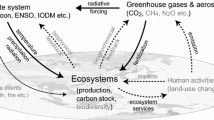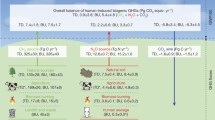Abstract
The High Resolution Biosphere Model (HRBM), which has been developed by the group of the author, was used to investigate the carbon balance of the vegetation and the soil in the ecosystems of Monsoon Asia in comparison to the rest of the world. The HRBM is a global grid-based (0.5 degree resolution) model with a monthly time step. It includes modules for natural vegetation, land use, vegetation fires, vegetation composition. A historical carbon budget was calculated for the period 1860–1978 and, on a global scale, validated using atmospheric CO2 data. Based on the per-country development of the population and their requirements, different reasonable scenarios were used to investigate the potential impacts of land use and deforestation in the period 1990–2050. The HRBM calculates considerable contributions of Monsoon Asia to the global CO2 emissions due to land use changes in the past. Between 1860 and 1978, about 1/4 of the global releases from land use changes came from South Asian and Southeast Asian biota. The future contributions in the period 1990–2050 depend on the assumed development of the agricultural methods. If the intensity of agriculture and the agricultural productivity will stay the same as in the 1980s, there will be a strong need to increase agricultural areas, and thus deforestation will dominate. If there will be a change over to intensive methods of agricultural production, the presently used areas might be sufficient to provide resources to the growing population.
Similar content being viewed by others
References
Alegre, J.C., Cassel, D.K. 1986. Effect of land-clearing methods and postclearing management on aggregate stability and organic carbon content of a soil in the humid tropics. Soil Science 142: 289–295.
Allen, J.C. 1985. Soil response to forest clearing in the United States and the Tropics: Geological and biological factors. Biotropica 17: 15–27.
Aselmann, I., Lieth, H. 1983. The implementation of agricultural productivity into existing global models of primary productivity. In: Degens, E.T., Kempe, S., Soliman, H. (eds.), Transport of carbon and minerals in major world rivers, Part 2, Mitteilungen aus dem Geologisch-Paläontologischen Institut der Universität Hamburg, SCOPE/UNEP Sonderband, Heft 55: 107–118.
Bulato, R.A., Bos, E., Stephens, P.W., Vu, M.T. 1990. World population projections 1989–90 edition short- and long-term estimates from the data files of the World Bank. Washington, D.C., The World Bank.
Esser, G. 1986. Der Kohlenstoff-Haushalt der Biosphäre: Struktur und erste Ergebnisse des Osnabrücker Biosphären Modells. Veröff. Naturf. Ges. zu Emden von 1814, Band 7 (Neue Reihe), 160 S.
Esser, G. 1987. Sensitivity of global carbon pools and fluxes to human and potential climatic impacts. Tellus 39 B: 245–260.
Esser, G. 1989. Global land use changes from 1860 to 1980 and future projections to 2500. Ecological Modelling 44: 307–316.
Esser, G. 1991. Osnabrück Biosphere Model: construction, structure, results. In: Esser, G., Overdieck, D. (eds.), Modern ecology, basic and applied aspects. Elsevier, Amsterdam New York, pp. 679–710.
Esser, G. 1993. Einfluß von Änderungen der Kohlendioxid: Konzentration in der Atmosphäre. In: Eingriffe der Landwirtschaft in den Kohlenstoffkreislauf. Studie A im Auftrag der Enquete-Kommission des Deutschen Bundestags ‘Schutz der Erdatmosphäre’, pp. 53–71 (in German).
Esser, G., Kohlmaier, G.H. 1991. Modelling terrestrial sources of nitrogen, phosphorus, sulphur and organic carbon to rivers. In: Degens, E.T., Kempe, S., Richey, J.E. (Eds.), Biogeochemistry of Major World Rivers. SCOPE 42, John Wiley & Sons, Chichester, pp. 297–322.
Esser, G., Hoffstadt, J., Mack, F., Wittenberg, U. 1994. High Resolution Biosphere Model (HRBM)—Documentation Model Version No. 3.00.00. Mitteilungen aus dem Institut für Pflanzenökologie der Justus-Liebig-Universität Giessen (Esser, G., series editor), Vol. 2, 70 pp. Giessen.
FAO-Unesco, 1974 ff. Soil Map of the World. Vol. I–X, Paris.
Ingestad, T., Lund, A.-B. 1986. Theory and techniques for steady-state mineral nutrition and growth of plants. Scand. J. For. Res. 1: 439–453.
Ingestad, T., Ågren, G. I. 1988. Nutrient uptake and allocation at steady-state nutrition. Physiol. Plant. 72: 450–459.
Lieth, H. 1975. Modeling the primary productivity of the world. In: Lieth, H., Whittaker, R.H. (Eds.), Primary productivity of the biosphere. Ecological Studies 14: 237–283. Springer Verlag, New YorkHeidelbergBerlin.
Mack, F. 1994. Zur Bedeutung von Vegetationsbränden für den globalen Kohlenstoffkreislauf. Dissertation im FB Biologie der JustusLiebigUniversität Giessen.
Nicholaides, J.J., Bandy, D.E., Sanchez, P.A., Benites, J.R., Villachica, J.H., Coutu, A.J., Valverde, C.S. 1985. Agricultural alternatives for the Amazon basin. Bioscience 35: 279–285.
Olson, J.S., Watts, without year (cv. 1983). Major world ecosystem complexes, ranked by carbon in life vegetation. Map prepared for the Carbon Dioxide Research Division of the U.S. DOE and the Ecosystems Studies Program of the National Science Foundation.
Olson, J.S., Watts, J.A., Allison, L.A. 1983. Carbon in live vegetation of major world ecosystems. Report for U.S. DOE, Oak Ridge National Laboratory, DOE/NBB-0037.
Overdieck, D., Forstreuter, M. 1991. Carbon dioxide effects on vegetation. In: Esser, G., Overdieck, D. (eds.), Modern ecology, basic and applied aspects. Elsevier, AmsterdamNew York, pp. 623–657.
Poorter, H. 1993. Interspecific variation in the growth response of plants to an elevated ambient CO2 concentration. Vegetatio 104/105: 77–97.
Richards, J.F., Olson, J.S., Rotty, R.M. 1983. Development of a data base for carbon dioxide releases resulting from conversion of land to agricultural uses. Institute for Energy Analysis, Oak Ridge Associated Universities, Oak Ridge, Tennessee 37831 (ORAU/IEA-82–10M, ORNL/TM-8801).
Roberts, W.P., Chan, K.Y. 1990. Tillage-induced increases in carbon dioxide loss from soil. Soil & Tillage Research 17: 143–151.
Schlesinger, W.H. 1977. Carbon balance in terrestrial detritus. Ann. Rev. Ecol. Syst. 8: 51–81.
Strain, B.R., Sionit, N. 1982. Direct effects of carbon dioxide on plants: A bibliography. Dept. of Botany, Duke University, Durham NC 27706. Report N.R.F. (DEB 78–23640).
Strain, B.R., Cure, J.D. (Eds.) 1985. Direct effects of increasing carbon dioxide on vegetation. U.S. Dept. of Energy, Publ. DOE/ER-0238, Washington DC.
Strain, B.R., Cure, J.D. 1986. Direct effects of atmospheric CO2 enrichment on plants and ecosystems: A bibliography with abstracts. ORNL/CDIC-13, Oak Ridge National Laboratory, Oak Ridge TN.
Whittaker, R.H., Likens, G.E. 1973. Carbon in the biota. In: Woodwell, G.M., Pecan, E.V. (Eds.), Carbon and the biosphere. CONF-720510, National Technical Information Service, Springfield, VA. S. 281–302.
Woodwell, G.M., Hobbie, J.E., Houghton, R.A., Melillo, J.M., Moore, B., Peterson, B.J., Shaver, G.R. 1983. Global deforestation: Contribution to atmospheric carbon dioxide. Science 222: 1081–1086.
Author information
Authors and Affiliations
Rights and permissions
About this article
Cite this article
Esser, G. Contribution of Monsoon Asia to the carbon budget of the biosphere, past and future. Vegetatio 121, 175–188 (1995). https://doi.org/10.1007/BF00044682
Accepted:
Issue Date:
DOI: https://doi.org/10.1007/BF00044682




